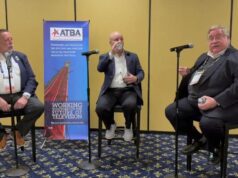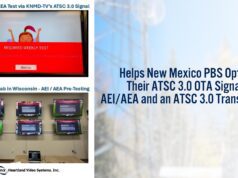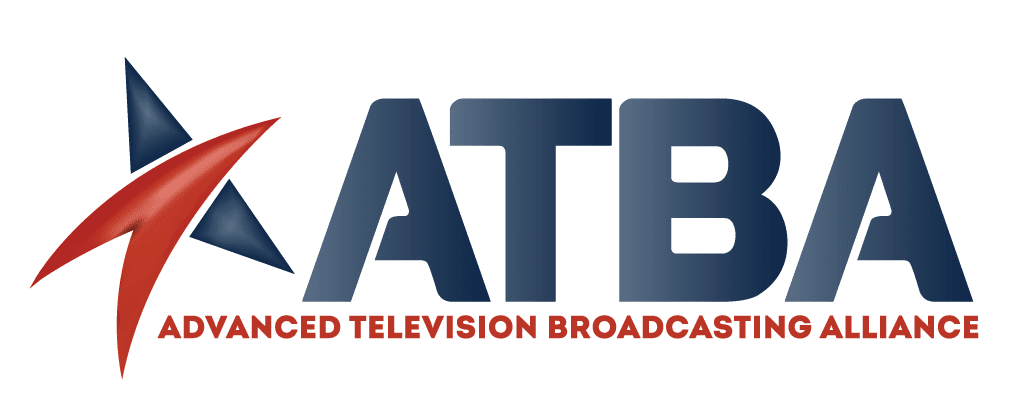COMMENTS OF THE ADVANCED TELEVISION BROADCASTING ALLIANCE
The Advanced Television Broadcasting Alliance (“ATBA”)1 respectfully submits these comments in response to the Petition for Rulemaking in this proceeding,2 wherein the Commission is asked to amend its rules to allow broadcasters to use the signaling portion of the physical layer of the new ATSC 3.0 (“Next Generation TV”) broadcast standard. More specifically, the Petition asks the Commission to (1) approve the Next Generation TV transmission standard as a new, optional standard for television broadcasting; (2) approve certain rule changes to permit local simulcasting to enable Next Generation TV to be deployed while ensuring that broadcasts in the current DTV standard remain available to viewers; and (3) specify that Next Generation TV transmission is ‘television broadcasting’ in parity with the current DTV standard, and otherwise to conform Sections 73, 74 and 76 of the rules to permit the deployment of this innovative new standard.
LPTV is an undeniably valuable medium that provides local service and programming not only to niche markets and small communities, but to segments of markets large and small. The Commission itself describes the underlying objectives of Low Power Television Service as follows:
The FCC created the Low-Power Television (LPTV) service in 1982 to provide opportunities for locally-oriented television service in small communities. These communities may be in rural areas or individual communities within larger urban areas. LPTV service offers programming tailored to the interests of viewers in small localized areas in a less expensive and more flexible way than traditional full-service/power TV stations. It has created opportunities for new entry into television broadcasting, provided a means of local self-expression, and permitted fuller use of the broadcast spectrum.
LPTV stations are currently undertaking their transition to digital operations.3
The importance of LPTV services is part of the Commission’s consistent vision for service to Americans. LPTV provides a unique entry point to ownership of broadcast facilities. A 2009 survey of LPTV stations conducted by the Community Broadcaster Association provided the following analysis of LPTV ownership and programming:
57% of LPTV stations have been on the air for more than 10 years
20% of LPTV stations have at least 10 employees
45% of LPTV stations are owned or partially owned by a minority.
43% of these stations have a minority owner of at least 51% of the station
24% of LPTV owners are Hispanic
10% of LPTV owners are African American
3% of LPTV owners are Asian
3% of LPTV owners are Native American
34% of LPTV owners are multi-racial
60% of LPTV stations are owned or partially owned by females
66% of LPTV stations offer at least some foreign-language programming
78% of LPTV stations that offer foreign language programming air at least 10 hours weekly of foreign language programming
83% of LPTV stations have local programming
49% of LPTV stations that have local programming air at least 10 hours of local programming each week
55% offer religious local programming
38% offer family-oriented local programming
36% offer local sports programming
31% offer local news
28% offer foreign-language local programming
TV translators also add to the diversity of programming available over the air, and at no cost, to Americans beyond the reach of one or more full power stations. They serve the public interest by typically reaching rural audiences, which are less affluent,4 and less educated,5 and disproportionately elderly6 and minority,7 as compared to the population generally. The existing
TV translator service has been available to these viewers for a period approaching a half century. Bringing at least one free, over-the-air broadcast service to all American communities, and then providing more channels and diversity to communities when possible, has been the overarching policy for use of the bands allocated to broadcasting services for decades.8 LPTV and TV translator stations are critically important to realizing these goals, and ATBA therefore supports the FCC’s commitment to preserving broadcast service and replacing broadcast service lost in the incentive auction.9
Yet low power television and TV translator stations face an uncertain future as a result of the broadcast incentive auction and subsequent industry-shaking repacking. Many LPTV and TV translator stations are likely to be forced off the air entirely, or will be forced to seek channel sharing arrangements to give them any hope of continuing to serve their communities. Further, even if channels are available for LPTV and TV translator stations, these broadcasters are not eligible for reimbursement of any costs associated with relocating such stations.
The ability of LPTV and TV translator broadcasters to maintain and enhance the service they provide is dependent on two fundamental factors: 1) the existential results of the broadcast incentive auction that will, by definition, reduce the amount of spectrum available to LPTV and TV translator broadcasters, and 2) the ability of remaining LPTV and TV translator operators to use forward-looking technology to remain on the air. Below, we discuss how and why The Next Generation TV broadcast transmission standard is essential to the second action.
Quick authorization for LPTV and TV translator stations to deploy the Next Generation broadcast standard, perhaps more than anything else the FCC can do, would help mitigate these unfortunate consequences. The two biggest challenges to LPTV and TV translators in repacking are (1) too few channels available to accommodate all displaced stations and (2) inability to use channels that would otherwise be available because they are too small or to irregularly shaped to be served effectively with a traditional single-tower architecture. Regarding the first challenge, the Next Generation TV standard provides a much higher effective bit rate, making channel sharing far more feasible in far more cases. Depending on local conditions and tradeoffs, it may be possible for a single RF channel to support several LPTV and/or TV translator streams while replication is sought. This capability is critically important, as the FCC’s incentive auction order acknowledges that demand for displacement channels is likely to exceed supply and encourages displacement applicants to coordinate to resolve mutual exclusivity.10 By giving LPTV and TV translator licensees the option to share costs and facilities even while improving service in many cases, the Next Generation TV standard can mitigate, to some degree, the damage of repacking and encourage investment by LPTV and TV translator operators in upgraded facilities.
The second challenge – potentially small and irregular areas available for displacement facilities – is equally daunting. The Next Generation TV standard’s Single Frequency Network (“SFN”) capabilities will bring a new dimension of flexibility to displaced LPTV and TV translator stations in the challenging work of finding post-auction channels in hard-to-fit places. In designing facilities, displacement applicants will not be limited to the capabilities of directional antennas. Instead, they could propose a SFN that might fit into irregular areas while still providing service to otherwise under-served areas.
Displaced licensees might find that the higher bit rates and SFN capabilities of the Next Generation TV standard combined create even more paths to preserving and enhancing service.
SFNs are likely to be costlier to build and operate, but by allowing the sharing of channels and operating costs, stations that are displaced might work productively with stations that are not displaced to improve service substantially by sharing costs that no single licensee could justify. Again, this is not a course of action being sought to remedy the unavailability of channels for allocation, but providing an interim course that allows the diverse programming offered to be available until final recourse is found.
The capabilities of the Next Generation TV standard are extremely important to preserving translator service, which brings the signals of major network affiliates and public broadcasters to rural areas. Most TV translator networks are “daisy-chained.” Like Christmas tree lights, if one goes out, so do those further down the chain. Thus, a single failed displacement could result in a hugely disproportionate loss of service: even if displacement channels are available further down the chain, they may not be able to fulfil their missions of extending service to the under-served because the programming does not reach them. Moreover, since many cable systems serving small communities rely on TV translators to receive the signals of major networks and public broadcasting, loss of one translator could result in a near total loss of broadcast service in a large area. Single Frequency Networks hold the promise of preserving these daisy-chains by allowing them to operate on a common, single, available channel, rather than different channels, which is necessary with existing technology.
Even in the best case scenario, the effects of the incentive auction and subsequent repacking on low power and TV translator facilities will be widespread and negative. The Next Generation TV standard can mitigate the damage by minimizing the loss of broadcast voices and greatly improving service by LPTV and translator stations that survive repacking. But realizing these benefits requires that equipment be available, and at reasonable costs, in time for licensees to propose Next Generation TV facilities in their displacement applications. Quick approval by the FCC for all broadcasters to use the Next Generation TV standard will, at this point, almost certainly result in equipment being available in time.
ATSC 3.0 is a mitigating technology that can help LPTV stations and TV translators to remain a viable part of the American broadcasting landscape. We believe that this petition is an important first step in finally providing assistance to LPTV and TV translators. Moreover, promoting advanced broadcasting service is a core mission of the ATBA. We therefore support the petition and are encouraged to see the public safety industries and the consumer electronics industries join broadcasters in together taking American television broadcasting into the 21st century. We urge the FCC to move with great speed to allow all broadcasters to unleash this innovation.
Respectfully submitted,
ADVANCED TELEVISION BROADCASTING ALLIANCE
/s/
By: Louis Libin Executive Director
/s/
By: Robert Folliard
Chairman
382 Forest Avenue
Woodmere, NY 11598
(516) 374-6700
May 26, 2016
1 ATBA is an organization comprised of thousands of low-power television (“LPTV”) broadcasters, owners and operators of broadcast translator and booster stations and services and allied industry organizations and companies. Unless otherwise stated or implied by the context, references to “LPTV” herein include low power television broadcast translator and booster stations and services.
2 See Joint Petition for Rulemaking of America’s Public Television Stations, The AWARN Alliance, The Consumer Technology Association, and The National Association of Broadcasters, GN Docket No. 16-142 (filed Apr. 13, 2016).
3 http://www.fcc.gov/guides/low-ower-television-lptv-service
4 See United States Department of Agriculture Economic Research Service, “Geography of Poverty”, available at http://www.ers.usda.gov/topics/rural-economy-population/rural-poverty-well-being/geography-of-poverty.aspx.
5 Id., “Rural Areas Lag Urban Areas in College Completion”, available at http://www.ers.usda.gov/amber-waves/2014-december/rural-areas-lag-urban-areas-in-college-completion.aspx#.V0SgOOQWYVA.
6 See Cornell University Cornell Chronicle, “Graying of rural America has policy implications”, July 3, 2013, available at http://news.cornell.edu/stories/2013/07/graying-rural-america-has-policy-implications.
7 See Housing Assistance Council Rural Research Brief, “Race & Ethnicity in Rural America”, April, 2012, available at http://news.cornell.edu/stories/2013/07/graying-rural-america-has-policy-implications.
8 See, e.g., Amendment of Section 3.606 of the Commission’s Rules and Regulations, Sixth Report and Order, 41 F.C.C. 148, 167 (1952) (establishing the FCC’s allotment priorities). These allotment priorities are to: (1) provide at least one television service to all parts of the country; (2) provide each community with at least one television broadcast station; (3) provide a choice of at least two television services to all parts of the country; (4) provide each community with at least two television broadcast stations; and (5) assign any remaining channels to communities based on population, geographic location, and the number of television services available to the community from stations located in other communities. The Commission’s television allotment priorities implement the policy goals of § 307(b) of the Communications Act. 47 U.S.C. § 307(b). In the Matter of Expanding the Economic and Innovation Opportunities of Spectrum Through Incentive Auctions, Report and Order, 29 FCC Rcd. 6567 (2014) (“Incentive Auction Order”) at ¶49.
9 See, e.g., Incentive Auction Order at ¶ 368 (“Nevertheless, we remain committed to the goals of section 307(b). To the extent that any loss in service results from the reverse auction, we will consider appropriate actions to address such losses. . . .”); see also, Incentive Auction Order fn. 1095 (“[B]ecause we recognize the importance of minimizing service disruption to viewers, we adopt expedited processing standards for displaced LPTV and TV translator stations as part of the post-auction band transition.”)
10 See In the Matter of Expanding the Economic and Innovation Opportunities of Spectrum Through Incentive Auctions, Report and Order, 29 FCC Rcd. 6567 (2014) at ¶ 661.
Read the FCC’s original media release here: The FCC%27s Coupe de Grace %3d The hits keep on coming DA-16-584A1













